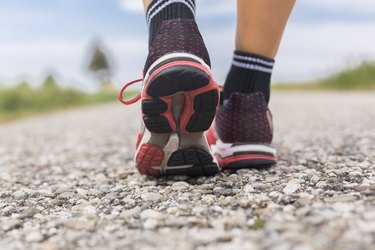
If your hands and feet tingle while you work out, it's not a normal part of exercise. It may be something as simple as being dehydrated or indicative of a more serious problem. Consult your doctor.
Tingling in the Hands
Video of the Day
Oxygen is important for breaking down sugars and fats for energy. It must reach its way to individual cells for your body to have sustained energy. Once your lungs deliver oxygen to your blood, your heart and arteries move the oxygenated blood to your contracting muscles.
Video of the Day
Your organs have a maximum capacity for oxygen and once it's depleted, your cells rely on a small reserve of oxygen and release lactic acid, which results in muscle pain and fatigue. Because your hands and feet are the furthest from receiving oxygen, overexercising quickly depletes the amount your extremities get. This can cause tingling and numbness.
Read more: The Dangers of Working Out Too Much
Electrolytes for Proper Functioning
Electrolytes are important for proper function of your muscles and nerves according to Rush University Medical Center. They regulate the body's hydration, blood pH and blood pressure while helping to rebuild damaged tissue. Muscle contractions need electrolytes. If there is an imbalance, your muscles can become weak or spasm.
Your body must have the proper balance of electrolytes, or system malfunctions can occur. You naturally lose electrolytes when you exercise as your body sweats. If you don't replace these electrolytes, you may experience tingling and numbness in your hands and feet. Other symptoms include dizziness, weakness, fatigue and nausea, according to BreastCancer.org.
Poor Circulation Can Cause Tingling
Poor circulation, or a lack of blood supply to your hands or feet, can cause numbness and tingling in the fingers during exercise. Exercising muscles require increased blood flow, so if blood flow is restricted somewhere in the body, it can lead to your extremities lacking in blood and oxygen.
A restriction of blood flow can result from plaque buildup in your legs, anxiety leading to a rush of adrenaline, smoking, vitamin deficiencies or cold weather. If you're exercising in temperatures that are too cold, the diminished blood flow causes decreased oxygen in your fingers and toes, resulting in a tingling feeling.
Illness and Medical Conditions
Certain medical conditions, such as diabetes, Raynaud's phenomenon, multiple sclerosis or a nerve injury, can cause tingling in your feet and legs when you exercise. Over time, people with diabetes can experience neuropathy — numbness or tingling in the extremities — due to nerve damage, notes the National Institute of Diabetes and Digestive and Kidney Diseases.
According to Mayo Clinic, Raynaud's phenomenon is a condition in which blood vessels abnormally constrict, restricting blood flow to the fingers and toes. It can be triggered by any type of stress to the body, such as exercise. Multiple sclerosis is an autoimmune disease that affects nerve cells. Damage to the nerves can cause tingling and numbness anywhere in the body. If you have sustained injury to your muscles, the nerves may also have been injured, which can result in tingling.
- National Institute of Diabetes and Digestive and Kidney Diseases: "What Is Diabetic Neuropathy?"
- MedlinePlus: "Numbness and Tingling"
- Mayo Clinic: "Raynaud's Disease"
- Rush University Medical Center: "Body Electric"
- BreastCancer.org: "Electrolyte Imbalance"
- UAB Medicine: Is Poor Circulation Giving You a Case of Cold Feet?